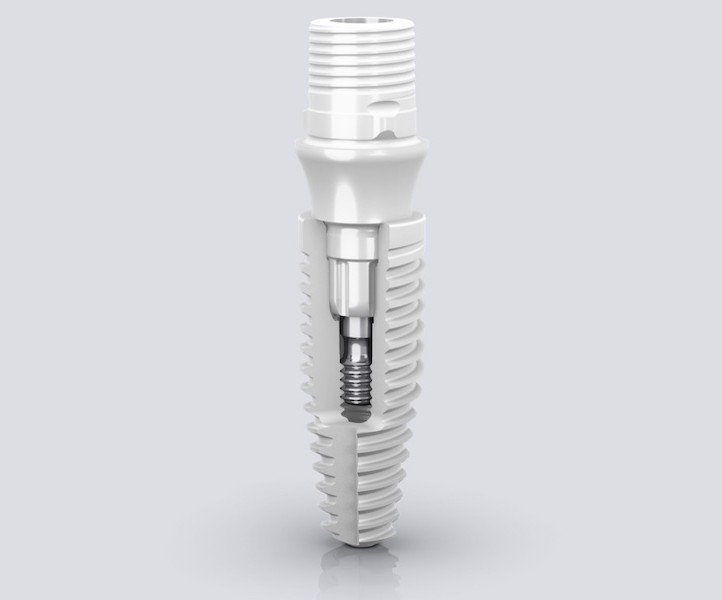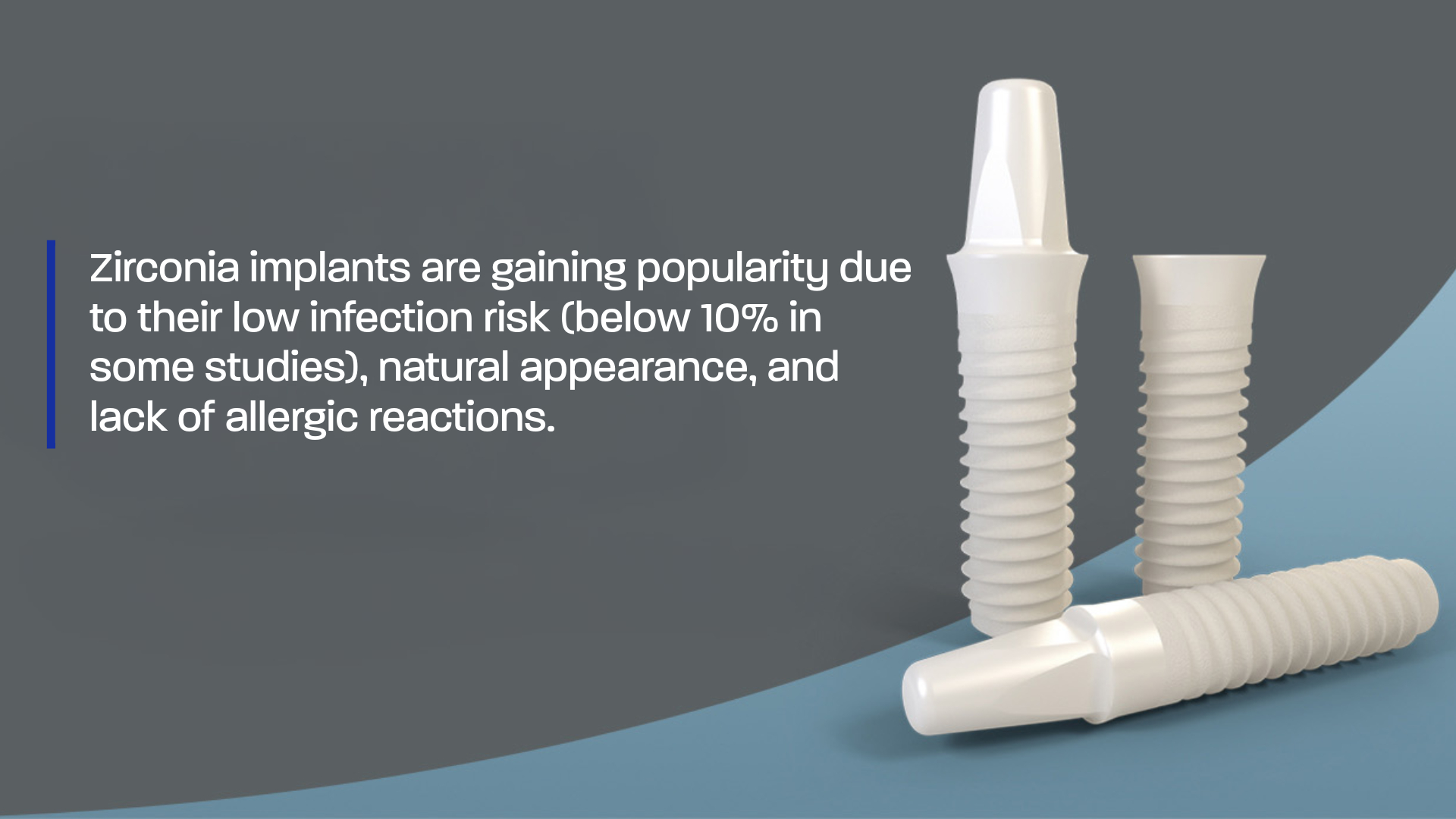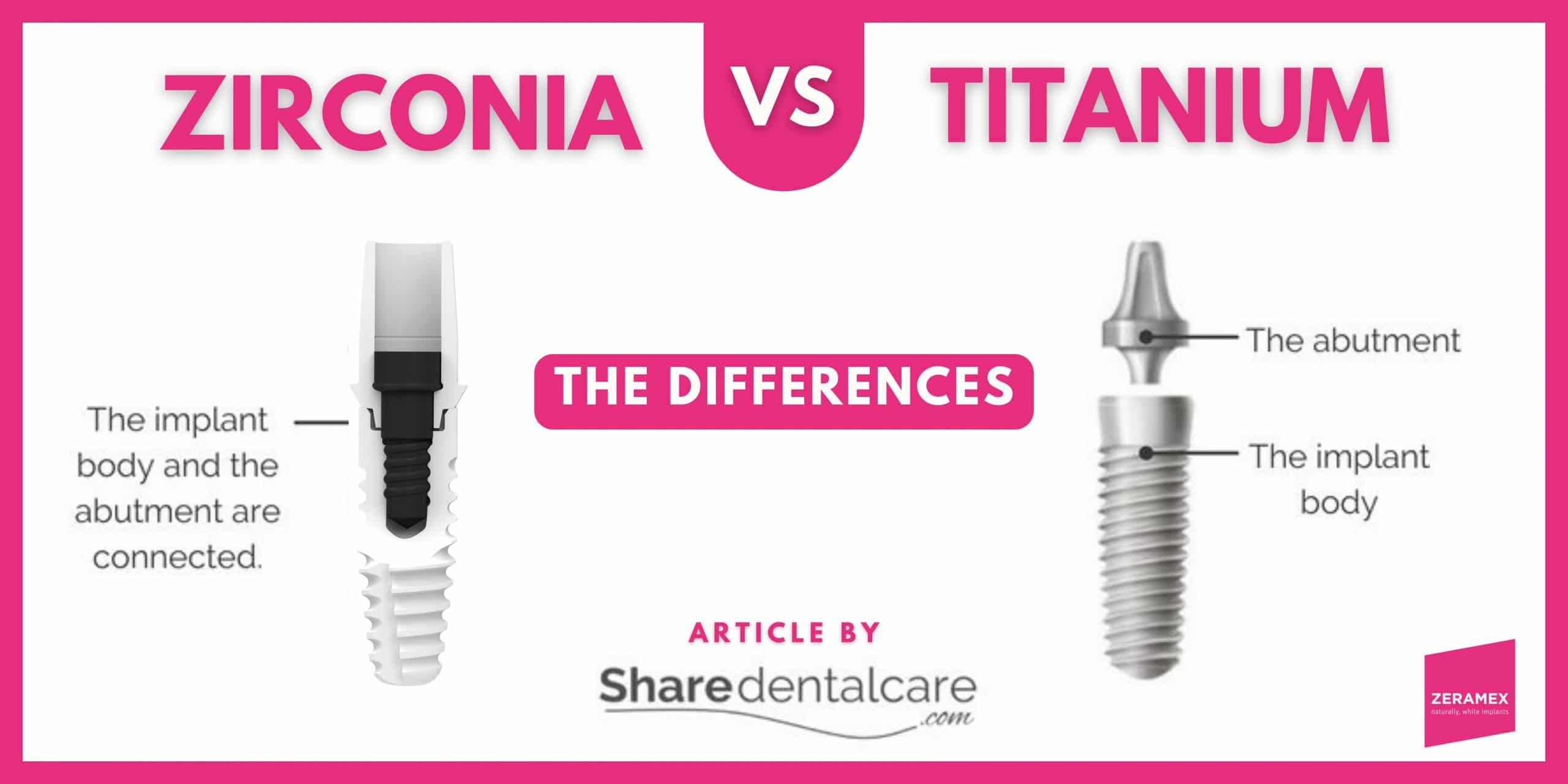Ceramic implants are metal-free dental implants made of white coloured zirconia-based material. (Generally, a ceramic called zirconium dioxide is used.) These implants offer a great alternative for patients who value aesthetics and are concerned about metal allergies. Zirconia, or ZrO₂ ceramic, is the primary component of ceramic implants. Ceramic implants made of alumina (Al₂O₃) were also tested up until the 1990s, but problems with their durability led to their removal from sale.

Nowadays, high-strength zirconia is the foundation of every ceramic implant system. To further enhance the mechanical strength of zirconia implants, aluminum oxide blended versions (ATZ) are occasionally utilized. Research shows that acid-treated zirconia surfaces are just as good as titanium when it comes to osseointegration, the process of combining the two materials. Yet research has demonstrated that zirconium surfaces can lessen the likelihood of infection by reducing bacterial adhesion.
Structure of Ceramic Implants

Ceramic implants are available in two different designs: one-piece and two-piece. In the one-piece design, the implant body and the abutment that joins the superstructure are a single piece. (The pictures above show an example of a one-piece ceramic implant and the implant placed in the mouth.) Two-piece ceramic implant systems have also been developed; in these designs, the implant body and abutment are separate parts.
The advantage of the one-piece design is that there is no gap at the implant-abutment junction and thus less risk of bacterial leakage. However, with this design, the freedom of prosthesis installation is limited and very precise positioning is required during implant placement. With two-piece ceramic implants, a screw interface is created; the abutment screws can usually be titanium, gold or ceramic. This makes the prosthetic procedure more flexible, but there may be an additional risk of micro-gaps.
How long do ceramic implants last?
Ceramic implants have shown to have an exceptionally high rate of long-term success in clinical trials. A recent systematic review revealed that the cumulative survival rate of ceramic implants is approximately 95% after 10 years. Another meta-analysis found a survival rate of around 97% at 5 years. These rates are similar when compared with titanium implants. In short-term comparative studies, there was no statistically significant difference in survival between ceramic and titanium implants at 12 months (1, 2).
Ceramic implants have only been used since 2014, so there is a lack of long-term data when compared to titanium implants. Titanium implants, on the other hand, have been widely used for 20-30 years and titanium has a proven superiority in long-term durability.
Another factor affecting the success of ceramic implants is the diameter of the implants. Ceramic implants with narrow diameter have a higher risk of fracture. Although implant fracture is a very rare complication, most of the fracture cases are seen in narrow diameter ceramics.
What are the advantages of ceramic implants?

The main advantages of ceramic implants are as follows.
Allergic Effects
Zirconia ceramics are considered biologically inert; they generally do not contain allergenic metals. Therefore, zirconia implants are recommended for patients with allergic sensitivity or chemically sensitive to titanium.
Aesthetic Advantages
The aesthetic appearance of ceramic implants is one of their most significant advantages. Particularly in the front tooth region, zirconium's white and light-reflecting natural tooth-colored structure makes the space under the gum line appear natural. When the gums recede around titanium implants, they can take on a metallic sheen that some patients find unappealing.
Clinical trials indicated that ceramic implant-supported restorations had a higher "pink aesthetic score" and were better at evaluating natural gingival harmony than titanium replacements. Because of this, zirconia implants are a good choice for people who have slim gums or a wide smile line.
Risk of Infection
The most common biological complication of dental implants is peri-implantitis. Data on the risk of infection in ceramic implants are mixed. Recent studies have reported that peri-implant mucositis and peri-implantitis are less frequently reported with zirconia implants. However, other reviews have noted over 10% of biological complications with ceramic implants.
What are the disadvantages of ceramic implants?
Risk of Fragility:
Ceramic (zirconia) is harder but less ductile than titanium. Particularly in regions with a small diameter or that bear the load at an angle, the implant body can break. Although the possibility of fracture has been reduced in new zirconia implants produced with high heat treatment, there is still a fragility disadvantage compared to titanium. Furthermore, the processes required when making a zirconia prosthesis (e.g. abutment angling) can reduce implant durability.
Limited Design/Prosthetic Flexibility:
Standard zirconia implants are typically made of a single piece, which means that they cannot be secured with screws but must be bonded together using cement. Although screws can be used in two-piece zirconia implants, the ceramic screw requires a very fine moment, and in most systems the internal screw is still titanium. Furthermore, the mono-block design does not allow for angular adaptation, making incorrect positioning difficult to correct. Zirconia implants may necessitate a marginally more exacting surgical technique when compared to titanium implants.
Less Clinical Study/Use Experience:
There is a wealth of clinical data available for titanium implants due to their long history of use. There is less established research on ceramic implants, and compared to titanium, the duration of follow-up care is shorter. Therefore, there are still uncertainties about long-term safety.
Infection and Other Complications:
Although ceramic implants are theoretically thought to reduce bacterial adhesion, some scientific studies have reported high rates of infection in ceramic implants. To illustrate the point, a review found that biological complications, such as peri-implantitis, occurred in 14.1% of cases involving ceramic implants and 12.9% of cases involving mechanical complications, such as screw loosening and porcelain cracking, compared to 5-10% in titanium implants. (1) Nevertheless, there are publications that contend that ceramics pose little risk of infection. Therefore, there is no consensus on this issue. Both types of implants involve the risk of infection if proper peri-implant hygiene is not observed.
Cost:
Ceramic implant systems usually cost 30 to 50 per cent more than their titanium counterparts. The limited number of brands producing ceramic implants has resulted in pricing being determined solely by these companies, leading to elevated costs.
Which implant is better: Titanium or ceramic?

For many years, titanium implants have been regarded as the industry standard. They exhibit exceptional mechanical strength, an extensive array of design alternatives, and demonstrated long-term efficacy.
Today, modern titanium implants have virtually eliminated the risk of allergic reactions due to the ceramic components they contain. However, some types of implants that do not meet industry standards can rarely cause allergic complications. In the literature, cases of titanium intolerance have been reported between 0.6% and 5%. In such special cases, completely metal-free ceramic implants stand out as a strong and biocompatible alternative.
The most powerful aspects of ceramic implants are their aesthetic and biocompatibility. The white colour of zirconium provides a much more natural appearance, especially in cases such as gingival recession in the anterior regions. In clinical studies, ceramic implants scored higher than titanium when evaluated by aesthetic criteria (such as pink aesthetic score). In addition, since ceramic material does not contain metal, it can be preferred for titanium-sensitive patients.
Conclusion;
Ceramic implants have several benefits, the most notable of which is their near-identical appearance to natural teeth and the nearly eliminated possibility of metal allergies that come with them. These implants are a great option for those who have aesthetic concerns, especially in the anterior region. Thanks to their partnership with market leader straumann, Antalara Dental can meet all of your demands for anterior ceramic implants. At our dental office in Antalya, we are ready to serve all of your dental need.
Sources;
1- Clinical outcomes of zirconia implants: a systematic review and meta-analysis, Published: 23 December 2023, Volume 28, article number 15, (2024)
2- Survival of zirconia implants: a systematic review and meta-analysis, : Bruno Ramos Chrcanovic- Master Thesis (30 hp) Malmö University Master Programme in Dental Science Faculty of Odontology March 2023-
